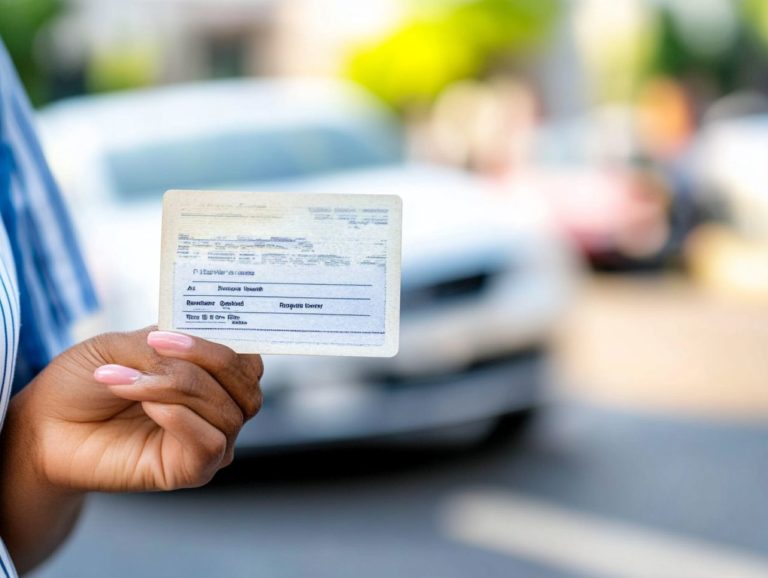What Are the Coverage Options for Motorcycles?
Riding a motorcycle grants you a sense of freedom and exhilaration. Be aware of the risks to enjoy riding safely!
One of the most effective ways to safeguard yourself and your investment is through insurance.
This article examines the essential types of motorcycle coverage, from liability to comprehensive options, while looking at the factors that influence insurance rates.
Whether you re a seasoned rider or just starting, understanding how to select the right coverage and save on premiums is vital.
Prepare to ride with the confidence that comes from being well-insured!
Contents
- Key Takeaways:
- Types of Motorcycle Coverage
- Factors Affecting Motorcycle Insurance Rates
- How to Choose the Right Coverage for Your Needs
- Tips for Saving Money on Motorcycle Insurance
- Frequently Asked Questions
- What Are the Coverage Options for Motorcycles?
- What is Liability Coverage for Motorcycles?
- What is Collision Coverage for Motorcycles?
- What is Comprehensive Coverage for Motorcycles?
- Do I Need Uninsured/Underinsured Motorist Coverage for My Motorcycle?
- Can I Customize My Coverage Options for My Motorcycle?
Key Takeaways:

- Insurance is vital for protecting against accidents and financial loss.
- Coverage options include liability, collision, and comprehensive coverage.
- Consider your riding habits, budget, and discounts when selecting coverage.
Why You Need Insurance for Your Motorcycle
Motorcycle insurance is not just a legal obligation; it s an essential safeguard for your investment and a source of peace of mind while you re on the road. With various types of coverage available such as liability, comprehensive, and collision you can protect yourself against the money problems that arise from accidents, theft, or damage. Providers like State Farm and Progressive offer tailored options, including roadside assistance and trip interruption coverage, designed to meet the diverse needs of riders like you.
Understanding the importance of motorcycle insurance goes beyond simply ticking a compliance box; it s about securing your financial future against unforeseen events. For example, comprehensive coverage shields you from damages not related to collisions, whether it s bad weather or vandalism, while liability coverage ensures you re protected if you unintentionally harm someone else.
Collision coverage helps you recover costs from accidents, potentially saving you from a hefty financial burden. With a wide array of coverage options available, assessing your specific insurance needs and aligning them with reputable providers is essential. This tailored approach brings you peace of mind and fortifies you against the emotional and financial challenges that can accompany unfortunate incidents.
Types of Motorcycle Coverage
Understanding the various types of motorcycle coverage available, including coverage for vintage motorcycles, is essential for making informed decisions that truly reflect your insurance needs.
Motorcycle insurance typically includes several key options. Liability coverage safeguards you against bodily injury and property damage, while collision coverage steps in during accidents. For those interested in electric bikes, understanding what is coverage for electric motorcycles is essential, as comprehensive coverage also offers protection against theft and other non-collision-related damages.
Each of these coverage types comes with its own limits and provisions. It is crucial for you to evaluate these features carefully to identify the best fit for your specific motorcycle insurance requirements, including understanding coverage for off-road vehicles.
Liability Coverage
Liability coverage is a crucial aspect of motorcycle insurance that financially shields you if you’re deemed at fault in an accident. It encompasses both bodily injury liability and property damage liability. This ensures that, in the unfortunate event of a motorcycle accident, injured parties and their property receive compensation. This protection is vital for safeguarding you against potentially devastating financial repercussions.
Make sure you understand the insurance requirements in your state to ensure that you have the appropriate limits to comply with local laws.
It’s important to distinguish between bodily injury liability, which covers medical expenses and rehabilitation costs for those injured in an accident, and property damage liability, which addresses the repair or replacement of damaged vehicles or property. Many states require minimum liability limits the lowest coverage amounts you must have by law but it’s wise to consider higher coverage for enhanced protection against unexpected financial burdens.
Being well-versed in these distinctions not only aids you in making informed insurance choices but also provides peace of mind. This allows you to enjoy your rides without the nagging worry of liability issues.
Collision Coverage
Collision coverage is a vital component of motorcycle insurance that offers you financial protection in the event of an accident, regardless of fault. It covers the cost of repairs or the total loss of your motorcycle, making it especially advantageous for high-value bikes like Harley-Davidson or Indian Chief, where repair costs can be quite steep. Additionally, understanding coverage for snowmobiles is also important for those who own multiple vehicles. Grasping the coverage limits of your policy is crucial, as these will influence any out-of-pocket expenses should an accident occur.
Understanding how collision coverage works is key for any motorcyclist. Not only does it address immediate repair costs, but it also safeguards the investment you ve made in your bike. When your motorcycle is damaged in an accident, collision coverage kicks in to cover repair costs up to the insured amount, providing you with a degree of financial relief.
It’s also important to distinguish this type of coverage from comprehensive insurance, which handles non-collision incidents like theft or vandalism. Being aware of total loss coverage, which refers to when your bike is damaged beyond repair, is essential. This understanding grants you peace of mind and clarity in your insurance decisions.
Comprehensive Coverage

Comprehensive coverage is an invaluable aspect of your motorcycle insurance, protecting you from non-collision-related incidents like theft, vandalism, and the whims of nature.
This type of insurance doesn’t just shield your motorcycle; it also covers a variety of situations that can catch you off guard. Whether it’s damage from falling objects, fire, or even an unexpected animal encounter, comprehensive coverage provides a safety net for those unfortunate surprises.
For many enthusiasts, motorcycles are more than mere vehicles they’re a canvas of personal style and engineering excellence. That’s why including coverage for custom parts and accessories is crucial; any modifications you’ve made can significantly elevate the bike’s overall value.
With comprehensive coverage in place, you can ride with confidence, knowing that your investments, both standard and customized, are protected against the unpredictability of life on the road.
Factors Affecting Motorcycle Insurance Rates
- Age
- Riding experience
- Type of motorcycle you own
- Driving record
Grasping the factors that influence motorcycle insurance rates is vital for riders who aim to secure the most advantageous prices and coverage. By carefully analyzing these elements, you can gain valuable insights into how to obtain competitive insurance quotes and potentially reduce your overall motorcycle insurance expenses.
In summary, understanding liability, collision, and comprehensive coverage, along with the factors that affect your rates, empowers you to make informed decisions about your motorcycle insurance. Don’t leave your financial security to chance explore your options today!
Age and Riding Experience
Age and riding experience are crucial for determining motorcycle insurance premiums. Younger or less experienced riders often face higher rates due to increased accident risks.
Insurers review your riding history, safety courses, and past claims. This helps identify discounts for safer riders, allowing you to navigate options with confidence.
As you gain experience, you ll develop better skills and road awareness, leading to safer riding habits. Enrolling in safety courses can positively impact your insurance rates.
These courses not only improve your abilities but also demonstrate your commitment to safety. Many insurers offer discounts for completing safety training, making your coverage more affordable.
As a seasoned rider with training certificates, you can enjoy lower premiums and more insurance options.
Type of Motorcycle
The type of motorcycle you ride plays a critical role in determining your insurance rates. Different classes like sport bikes, cruisers, and touring motorcycles carry varying levels of risk based on their performance features and popularity among riders.
High-performance models, such as the Honda CBR or Suzuki GSXR, often come with higher premiums due to their speed and the potential for accidents. In contrast, cruising models like the Harley-Davidson or Indian Chief typically offer more budget-friendly insurance options.
Insurance providers assign distinct ratings for various motorcycle types, directly influencing overall insurance costs.
Understanding these distinctions allows you to make informed choices. Compare models known for aggressive speed against those designed for comfort and leisurely rides.
Standard motorcycles, recognized for their balanced performance, often strike a middle ground in pricing. Insurance companies evaluate the type of motorcycle alongside factors like repair costs, engine size, and top speed, resulting in a range of pricing structures.
As a savvy rider, you can explore these nuances and policies from various providers to secure the best coverage and value tailored to your specific motorcycle type.
Driving Record
Your driving record significantly influences your motorcycle insurance rates. A spotless history, free from accidents or violations, often leads to lower premiums and opportunities for claim-free policy discounts.
On the flip side, a record with infractions may place you in the high-risk category, resulting in elevated insurance costs.
Insurers examine your driving history to assess your responsibility behind the wheel, directly impacting your eligibility for various coverage options and discounts.
The importance of maintaining an impeccable record cannot be overstated; it affects your initial quotes and future renewals. When insurers evaluate claims, they consider the frequency and severity of past incidents, which can raise rates for those with problematic histories.
Individuals who consistently demonstrate safe riding habits may qualify for special programs or loyalty discounts, making their insurance more affordable.
A positive driving record serves as a protective barrier, shielding you from unnecessary financial burdens regarding motorcycle coverage.
How to Choose the Right Coverage for Your Needs

Selecting the ideal motorcycle insurance coverage demands a careful look at your individual insurance needs, riding habits, and budget constraints.
Start by evaluating the different types of coverage options available, such as liability, collision, and coverage for classic motorcycle insurance. Identify which policies resonate with your riding style and financial situation.
Talking to knowledgeable insurance agents provides valuable insights into various quotes. This guidance helps you secure adequate protection while keeping your expenses in check.
Evaluating Your Riding Habits and Budget
Assessing your riding habits and budget is crucial in determining the motorcycle insurance coverage that fits your lifestyle. Consider how often you ride, the types of trips you take, and whether you might benefit from additional features like roadside assistance or trip interruption coverage.
Striking a balance between your coverage options and financial constraints will guide you toward a policy that meets your needs while offering potential savings.
Understanding these various aspects of your riding habits can lead to meaningful adjustments in your premiums. For example, if you frequently ride long distances on weekends, your coverage needs will differ from those who primarily commute.
Choosing a higher deductible can effectively lower your premium while ensuring you have adequate coverage in the event of an accident. Regularly reviewing your policy can lead to big savings!
Additionally, explore discounts for safe riding courses or bundling multiple insurance policies, which can enhance your savings while maintaining essential coverage.
Tips for Saving Money on Motorcycle Insurance
Discovering ways to save on motorcycle insurance not only boosts your financial well-being but also ensures you keep the coverage you need.
There are several strategies at your disposal, such as:
- Seeking available insurance discounts
- Considering the benefits of bundling your motorcycle policy with other insurance types
- Maintaining a claim-free record to enjoy lower premiums over time
By exploring these options, you can unlock substantial savings on your insurance without compromising on essential coverage.
Discounts and Bundling Options
Many motorcycle insurance providers offer a range of discounts and bundling options designed to help you save significantly on your premiums. Discounts may include safe rider incentives, multi-policy discounts for bundling with home or auto insurance, and loyalty rewards for long-standing customers.
Some companies even provide discounts for completing safety courses or for being a member of affiliated riding groups. Inquire about seasonal promotions or limited-time offers that could lower your costs.
When requesting quotes, take the time to discuss these possibilities to uncover hidden savings opportunities. This transforms your insurance policy from a mere necessity into a financially savvy choice that aligns perfectly with your budget.
Frequently Asked Questions
What Are the Coverage Options for Motorcycles?

The coverage options for motorcycles typically include liability, collision, comprehensive, and coverage for motorcycle enthusiasts, as well as uninsured/underinsured motorist coverage.
What is Liability Coverage for Motorcycles?
Liability coverage for motorcycles provides financial protection if you cause an accident that results in injuries or property damage to others. It helps cover the costs of legal fees, medical bills, and property repairs.
Get a quote today to find the best motorcycle insurance coverage for you!
What is Collision Coverage for Motorcycles?
Collision coverage pays for repairs or replacement if your motorcycle is harmed in an accident. You’ll need to cover a deductible this is the amount you pay before your insurance kicks in.
What is Comprehensive Coverage for Motorcycles?
Comprehensive coverage protects against damage from theft, vandalism, or natural disasters, not just accidents. It also involves a deductible that you need to pay first.
Do I Need Uninsured/Underinsured Motorist Coverage for My Motorcycle?
While not legally required, uninsured/underinsured motorist coverage is a smart choice. It safeguards you in case of an accident with someone lacking sufficient insurance.
Can I Customize My Coverage Options for My Motorcycle?
Absolutely! You can tailor your coverage to meet your unique needs and budget. Adjust coverage limits, add or remove options, and choose a deductible that suits you.






